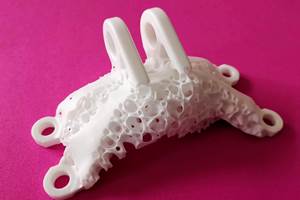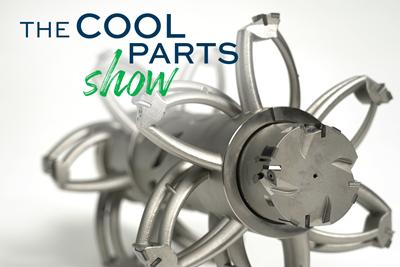3D Printed Cutting Tool for Large Transmission Part: The Cool Parts Show Bonus
A boring tool that was once 30 kg challenged the performance of the machining center using it. The replacement tool is 11.5 kg, and more efficient as well, thanks to generative design.
Share
Transportation component maker Voith formerly used cutting tools that were nearly too heavy for its CNC machining centers in a boring operation for transmission housings of large vehicles. Inspired by a generatively designed cutting tool for machining the stator bore of electric motors, Voith turned to cutting tool maker Kennametal to develop a cutting tool for its application made using generative design for lightweighting along with 3D printing to produce the resulting form. The new tool is less than half the weight, reducing the maintenance needs of the machine using it while also allowing Voith to decrease machining cycle time because of the faster acceleration of the tool.| This episode of The Cool Parts Show brought to you by Carpenter Additive
The Cool Parts Show is a video series from Additive Manufacturing Media that explores the what, how and why of unusual 3D printed parts. Watch more here.
Have a cool part to share? Email us.
Related Resources
- Voith
- Kennametal stator bore tool, seen on The Cool Parts Show
- Additive manufacturing capability at Kennametal
- Articles on generative design
- More of what we saw at Formnext 2022
- Get our new newsletter, The BuildUp
Transcript
00:00:00:09 - 00:00:00:20
Pete Zelinski
I'm Pete.
00:00:01:06 - 00:00:01:22
Stephanie Hendrixson
I'm Stephanie.
00:00:01:22 - 00:00:10:07
Pete Zelinski
Welcome to The Cool Parts Show Bonus Episode. Stephanie, I want to do a follow up. Do you remember the episode we did about the Kennametal stator bore tool?
00:00:10:07 - 00:00:33:12
Stephanie Hendrixson
Yeah. So that was a tool for cutting these bores in motor housings for electric vehicles. And if I recall, the issue was that the user wanted to be able to make that cut all in one go, but doing that with a conventional cutting tool, the tool would have been too heavy for their machinery. And so Kennametal was able to develop and design this 3D printed tool that was lightweighted and able to do that job.
00:00:33:14 - 00:00:59:10
Pete Zelinski
And it looked strange because it was made through generative design. And I have got an even weirder 3D printed cutting tool. The manufacturer using this tool is Voith, in Germany. They make transportation parts. The part this tool is used on is a big transmission housing. Think like for vehicles, like busses, this tool machines a large precise bore in that housing.
So the tool that we're seeing, it spins very rapidly inside of a machining center so that it can precisely cut the diameter, actually varying diameters, of that big hole.
00:01:10:17 - 00:01:16:20
Stephanie Hendrixson
Okay. So this is starting to sound familiar. Was this cutting tool 3D printed for some of the same reasons as that other one.
00:01:17:14 - 00:01:24:14
Pete Zelinski
Actually? Yeah. So this tool was also developed by Kennametal and it was inspired by that stator bore tool you described.
00:01:24:23 - 00:01:25:16
Stephanie Hendrixson
That's pretty neat.
00:01:25:23 - 00:01:51:06
Pete Zelinski
One difference is that Voith has actually been machining this transmission housing for quite a long time and they have been machining it using a more conventionally designed, large, boring tool. So a much heavier tool. And the way Voith was dealing with this is they were just accustomed to frequent maintenance on their machine tool resulting from using this oversize over heavy cutting tool.
They saw the stator bore tool. They knew the lightweighting that it achieved could really help them, too. So this tool was also generatively designed for lightweighting within their boring application. And so where that original tool was like 30 kilograms, this new tool is just 11 and a half kilograms much lighter, and four and a half kilograms alone is for the tool holder, not even the tool, but the holder that holds it in the machining center.
00:02:21:06 - 00:02:36:15
Stephanie Hendrixson
That's pretty significant weight savings. But I'm looking at this and I'm wondering if there are other similarities with that previous tool that we highlighted. One of the features of that stator bore tool was there were actually coolant lines through that crazy geometry to take coolant to the cutting edges. Is that happening here too?
00:02:37:00 - 00:03:28:23
Pete Zelinski
It is. But yes, this is a messy geometry. One thing about generative design, it does not care about realizing a visually tidy form. It just mathematically tries to optimize around the parameters you give it, toward the goal you set for it. And the objective here was lightweighting, but also, yeah, in combination with delivering coolant through the inside of this crazy form to send high pressure coolant to all of those different cutting edges to push chips out of the way as machining occurs. I should say the inserts themselves, the cutting edges are not 3D printed, they are polycrystalline diamond, PCD precisely mounted on the tool and also similar to the stator bore tool, it's actually precision machining multiple diameters at once. One pass hits a sequence of different diameters because different sets of those cutting edges are mounted at different diameter sizes along the span of the tool.
00:03:44:15 - 00:03:50:17
Stephanie Hendrixson
So a lot of really interesting things going on with this tool. But where are they with this right now? What benefits are they realizing?
00:03:51:06 - 00:04:16:23
Pete Zelinski
Benefits, increased machine availability because there's less downtime for maintenance now and also more productivity because the cycle time for this operation is reduced, partly because the more lightweight tool it's possible to accelerate it faster up to its cutting speed, decelerate it back down when it's done. The result is the cycle time for this cut is half what it used to be.
00:04:17:11 - 00:04:24:17
Stephanie Hendrixson
All right, that's it for this bonus episode of The Cool Parts Show. If you want to see our full episode on that stator bore tool, check out the links in the show description.
00:04:25:05 - 00:04:39:06
Pete Zelinski
Thank you to my sources I talked to about this tool, Friedrich Oberlaender of Voith and Werner Penkert of Kennametal. I spoke to them at the recent Formnext show to see what else I saw at that show, I'll put a link in the show description.
00:04:39:14 - 00:04:40:08
Stephanie Hendrixson
Thanks for watching.
Related Content
User-Friendly Mass Spectrometry Tool to Enable AM
The Massbox is a technology designed to simplify mass spectrometry by bypassing the need to send samples to the lab for characterization and testing purposes. Exum Instruments’ debut tool is suitable for AM as it can assist with quality assurance, material characterization and failure analysis.
Read MoreDecentralized Manufacturing Network Aims to Make 3D Printers a Shared Global Resource
The 3DOS additive manufacturing network will let OEMs and creators take advantage of open 3D printer capacity anywhere in the world.
Read MoreSpherene Creates Metamaterial with Geometry Derived from Spheres
An algorithm developed by Spherene Inc. generates Adaptive Density Minimal Surfaces (ADMS) as a self-supporting infill strategy that can be used to reduce mass and manage material properties in 3D printed parts.
Read MoreHybrid Additive Manufacturing Improves Debarking Knife Tip Strength and Production Efficiency
Nicholson Manufacturing chose the Mastercam APlus specialized add-on to unlock hybrid manufacturing for making its debarker knife tips, enabling it to add durable layers to the wear surfaces of the tips to make them more resilient while also making the production process more efficient.
Read MoreRead Next
3D Printed Tool for Machining Electric Vehicle Motors: The Cool Parts Show #39
Additive manufacturing achieves a large-diameter cutting tool light enough for fast, precise machining of the motor housing’s stator bore.
Read MoreProfilometry-Based Indentation Plastometry (PIP) as an Alternative to Standard Tensile Testing
UK-based Plastometrex offers a benchtop testing device utilizing PIP to quickly and easily analyze the yield strength, tensile strength and uniform elongation of samples and even printed parts. The solution is particularly useful for additive manufacturing.
Read MorePostprocessing Steps and Costs for Metal 3D Printing
When your metal part is done 3D printing, you just pull it out of the machine and start using it, right? Not exactly.
Read More















